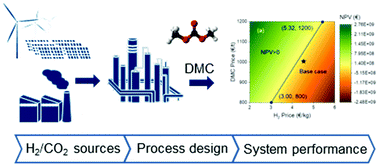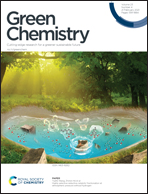Greener production of dimethyl carbonate by the Power-to-Fuel concept: a comparative techno-economic analysis†
Abstract
Power-to-Fuel is an emerging concept that uses surplus electricity-powered H2 and CO2 to produce future fuels. Previously studied fuel candidates include methanol, Fischer–Tropsch, and ethers. Apart from these candidates, dimethyl carbonate (DMC) is increasingly recognized as a viable fuel. Various new production pathways are being actively developed encouraged by its wider range of applications. In this study, we first performed a preliminary screening of available pathways with respect to their levels of technical maturity and their compliance with green chemistry principles. The selected pathways are oxidative carbonylation of methanol, direct urea methanolysis as well as indirect urea methanolysis via ethylene carbonate and propylene carbonate routes. We designed the processes and simulated the material and energy balances in the context of the Power-to-Fuel concept. Subsequently, a techno-economic analysis was performed to assess their viability. From the analysis, we found that the process steps of methanol and urea syntheses are the major capital investment contributors, rather than the DMC synthesis step itself. The direct urea methanolysis exhibits the highest energy efficiency of 48.5% and the lowest cost of manufacturing (COM) of 2.19 € per lDE. The oxidative carbonylation of methanol is featured with the lowest capital expenditure (CAPEX) and utility consumption. Both the indirect urea methanolysis pathways have better conversions than the direct urea methanolysis, but their advantages can only be seen provided that the utility consumption is minimised. Under current market conditions, only the direct urea methanolysis pathway is slightly profitable by the net present value (NPV) and minimum selling price (MSP). The hydrogen price is found to be the dominant economic driver of all pathways, with the oxidative carbonylation of methanol in particular.



 Please wait while we load your content...
Please wait while we load your content...